
Assemble a team of Disney and Pixar characters and fight for victory in the arena!
What Is Disney Sorcerer’s Arena: Epic Alliances?
Disney Sorcerer’s Arena: Epic Alliances (yes, the full title is a mouthful!) is a tactical strategy game for 2 or 4 players, ages 13 and up, and takes about 35 minutes to play. It was released in the middle of last year, and actually has a couple of expansions out now as well. It retails for $49.99 and is available in stores and online, as well as directly from The Op Games.
Disney Sorcerer’s Arena: Epic Alliances was designed by Sean Fletcher and published by The Op Games, with illustrations by Patrick Spaziante.
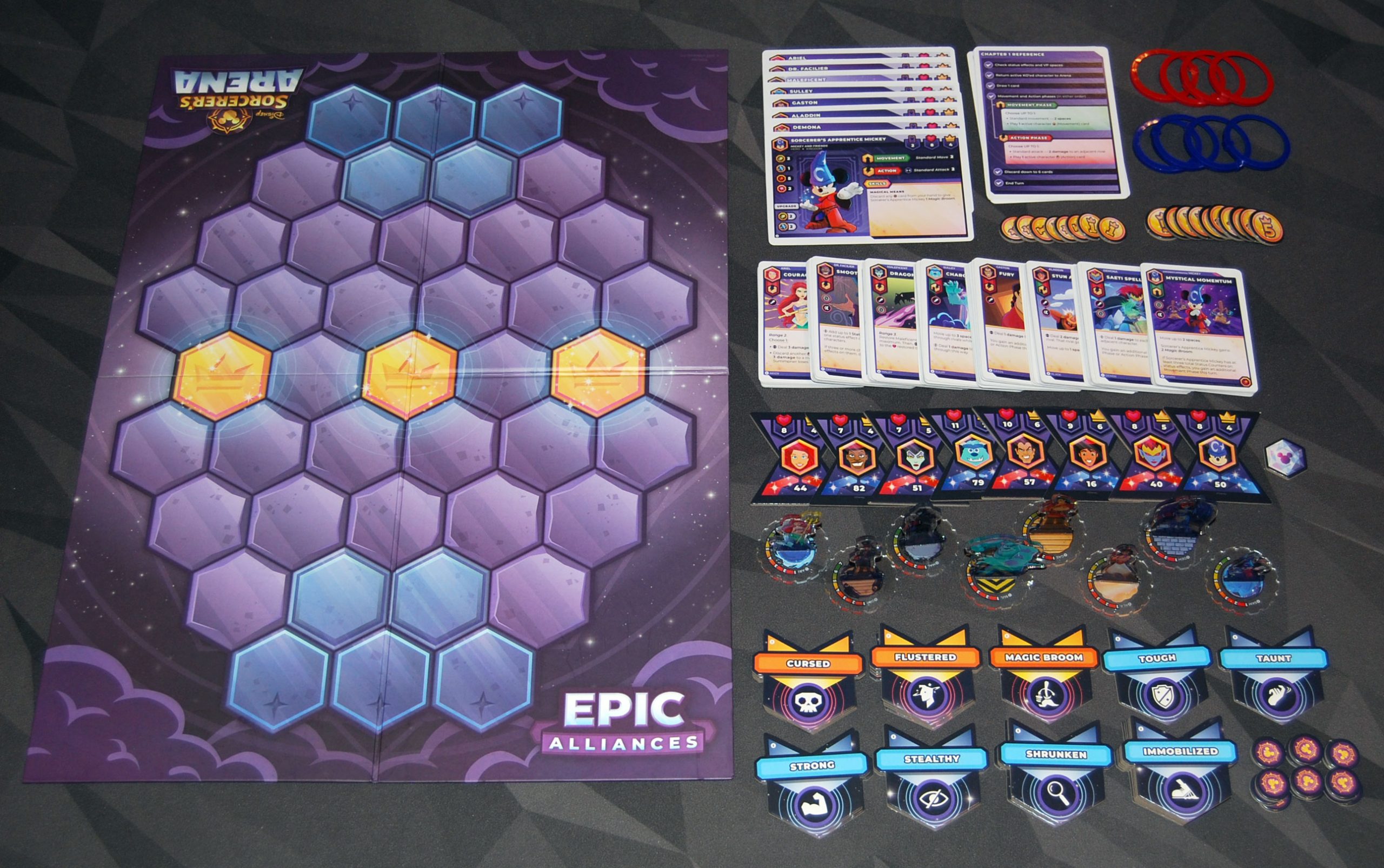
Disney Sorcerer’s Arena: Epic Alliances Components
Here’s what comes in the box:
- Arena game board
- 8 Character Ability cards
- Sorcerer’s Apprenttice Mickey
- Gaston
- Maleficent
- Aladdin
- Demona
- Ariel
- Dr. Facilier
- Sulley
- 8 Character decks (10 cards each)
- 4 Reference cards
- 8 Base rings (4 red, 4 blue)
- 8 Character standees with bases
- 8 Character Turn Order tokens
- Turn marker
- 15 Status Counter tokens
- 18 Victory Point tokens (8 1-point, 10 5-point)
- 24 Status Effect tokens
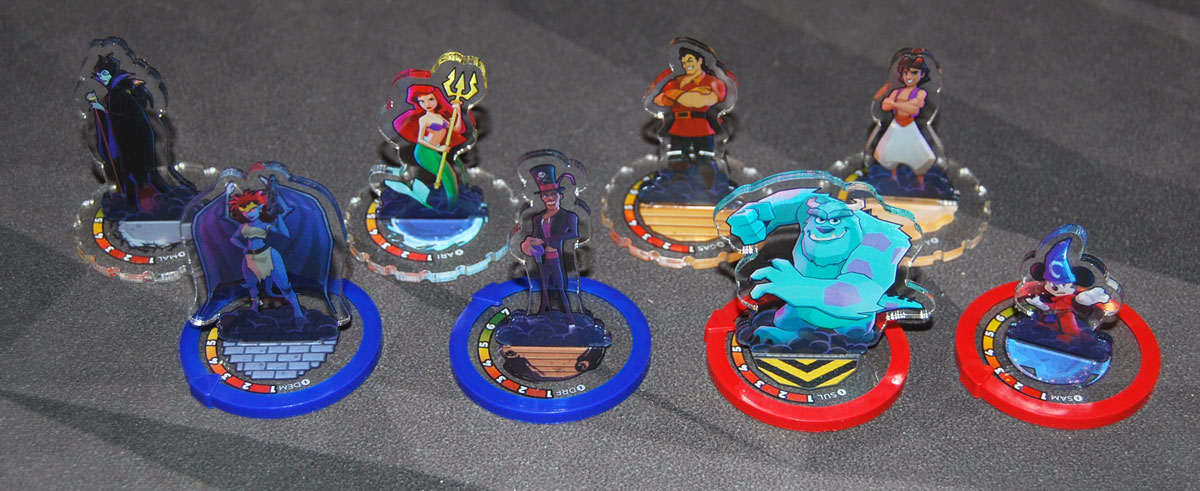
The character standees and bases are made of clear acrylic (don’t forget to peel off the protective plastic!)—I saw somebody refer to them as “shrinky dinks” and they do kind of have that look to them, though they’re not warped and bent like my shrinky dinks always seemed to turn out. Each base has a 3-letter abbreviation for the character, a health track, and a little illustration for the “ground”—a splash of water for Ariel, a patch of sand for Aladdin, and so on. The base rings snap onto the bottom to distinguish between the red team and the blue team, and each has a little arrow so that you can use the ring to track the character’s health.
The illustrations for the game look like the app the tabletop game is based on: they have that slightly polygonal look of 3D models with a cel animation filter. If you didn’t know this game was based on an app, it may be a bit confusing why these look like video game characters.
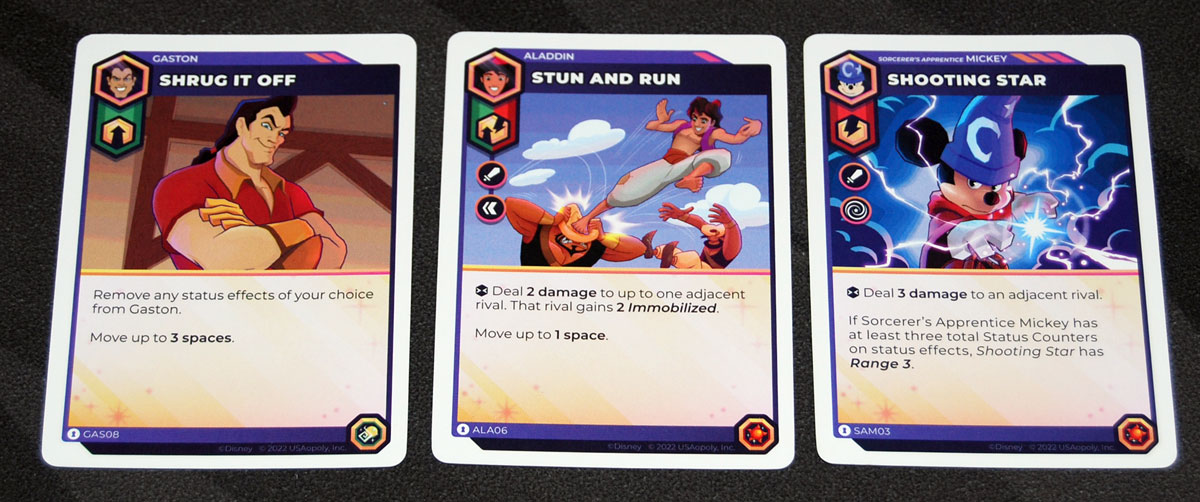
Each character’s cards has their face in the top corner so they’re easy to sort out, and the iconography is pretty easy to follow for the most part. They’re marked with an arrow or a lightning bolt to differentiate between movement and action cards, and additional icons in the effect will indicate whether it’s a direct effect (you choose a target) or indirect effect (the card indicates which characters are affected). Each card also has a “gear” in the lower right corner, to be used in the most advanced mode.

The turn order tokens are shaped like hourglasses, with the character’s face in the middle. At the top it shows their starting health and how many points they’re worth if you knock them out. The tokens are double-sided with red or blue at the bottom so you can flip them to the appropriate team. The large number at the bottom is the initiative number, and is used in the more advanced chapters to help set turn order.

The status effect tokens are large cardboard tiles that fit against the turn order tokens—there are both positive and negative effects.

The box itself is made to look like a chest with a big lock on one side, though the printed “lid” doesn’t actually open that way. There’s also a die-cut sleeve that depicts the eight included characters, but that covers up the chest, so I’m not sure if I’ll keep the sleeve on or not. The included plastic insert has slots to keep everything sorted and organized, but unfortunately has no room for expansion at all, so if you get the expansions you’ll either have to keep all of the small boxes in addition, or else ditch the insert and just bag everything up.
How to Play Disney Sorcerer’s Arena: Epic Alliances
You can download a copy of the rulebook here. Sorcerer’s Arena has four “chapters” that gradually introduce the game concepts, so you can learn the basics without getting overwhelmed with a whole lot of rules thrown at you all at once. I won’t go through all the individual chapters separately, but will give some indications about what gets added.
The Goal
The goal of the game is to be the first to score a certain number of victory points (VP), or have the most VP when the game ends.
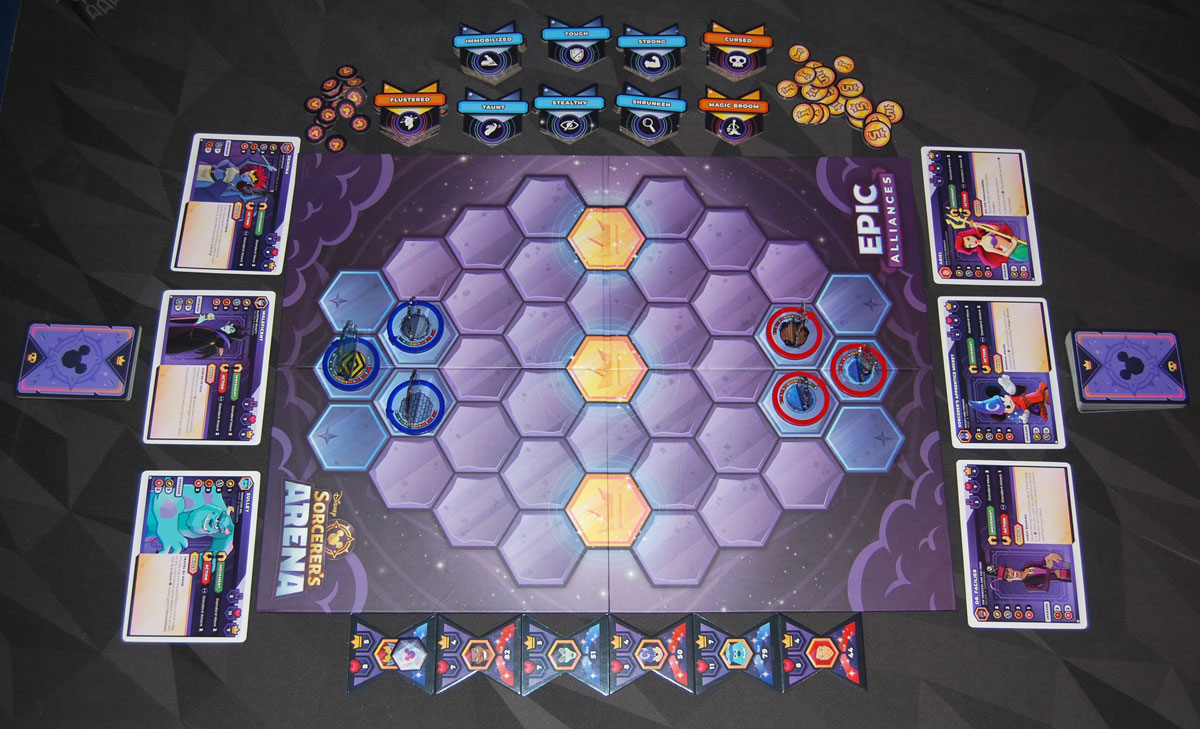
Setup
Generally, you’ll choose teams from among the various characters: in the first chapter teams are assigned (Mickey and Aladdin vs. Gaston and Ariel) but later on you’ll get to draft characters and have 3 characters per team (or 4 if you’re playing the 2-vs-2 variant).
The turn order markers are placed along the side of the board (there’s a way to bid for initiative in later chapters), alternating between teams, and the turn order token is placed on the first one. The characters start in the blue spaces on their end of the arena with full health. Each player takes the character reference cards for their characters, and then shuffles their two (or three) character decks together to form a single deck.
The rest of the tokens are placed nearby as a supply.
Gameplay
When the turn order marker is on your character, that character gets a turn.
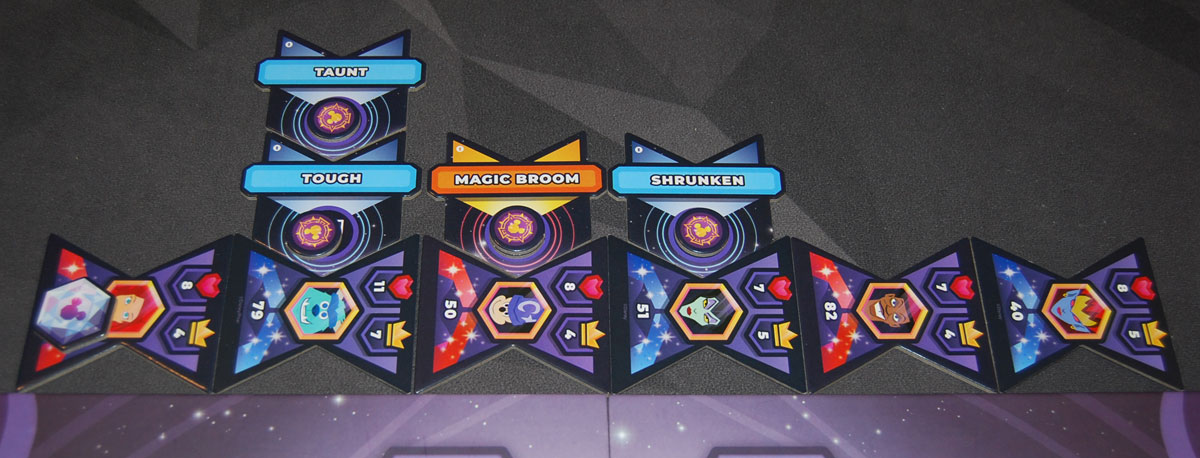
Starting Phase – check status effects and points
The first thing you do is to resolve status effects: if there are any effects next to your turn order token, you remove one status counter. If that was the last status counter, the effect itself is also removed.
Then, if your active character is standing on one of the three golden VP spaces in the center of the arena, you take 1 VP. If your character has been knocked out and is off the board, you place it on the board in the back row of either end of the arena at full health.
Draw 1 card from your deck.

Main Phase – where most of the action happens!
Your character may take one movement and one action, in any order. You may only play cards that match the current character. To move, you may either play a movement card and follow its instructions, or take a standard move of 2 spaces. Action cards vary by character but may include attacks, healing, placing status effects, and more. You may also take a standard attack for your action instead of playing a card by dealing 2 damage to an adjacent character. (There are some characters who have a different standard move or standard attack once you get to the later chapters.)
Health is tracked by rotating the base ring. If your health goes down to 0, your character is KO’d and is removed from the board, and all status effects are removed from your character. The player who knocked you out gets the VP shown on your character’s turn order tile.
In later chapters, you may also use one of your character’s skills once per turn—these are printed on the character card. In addition, each character can be upgraded: if you have the right “gears” on the cards in your discard pile, you may banish cards (putting them back into the game box) to flip your character card over, unlocking an additional ability.
Ending Phase – discard down
If you have more than six cards, you must discard down to six. Then move the turn order marker to the next character in line.
Game End
At the end of a round—when every character has had one turn—if either team has scored at least 20 VP or if any player needs to draw a card but has none left, then the game ends and the team with the most points wins. (In the first chapter, the victory threshold is 12 VP.)
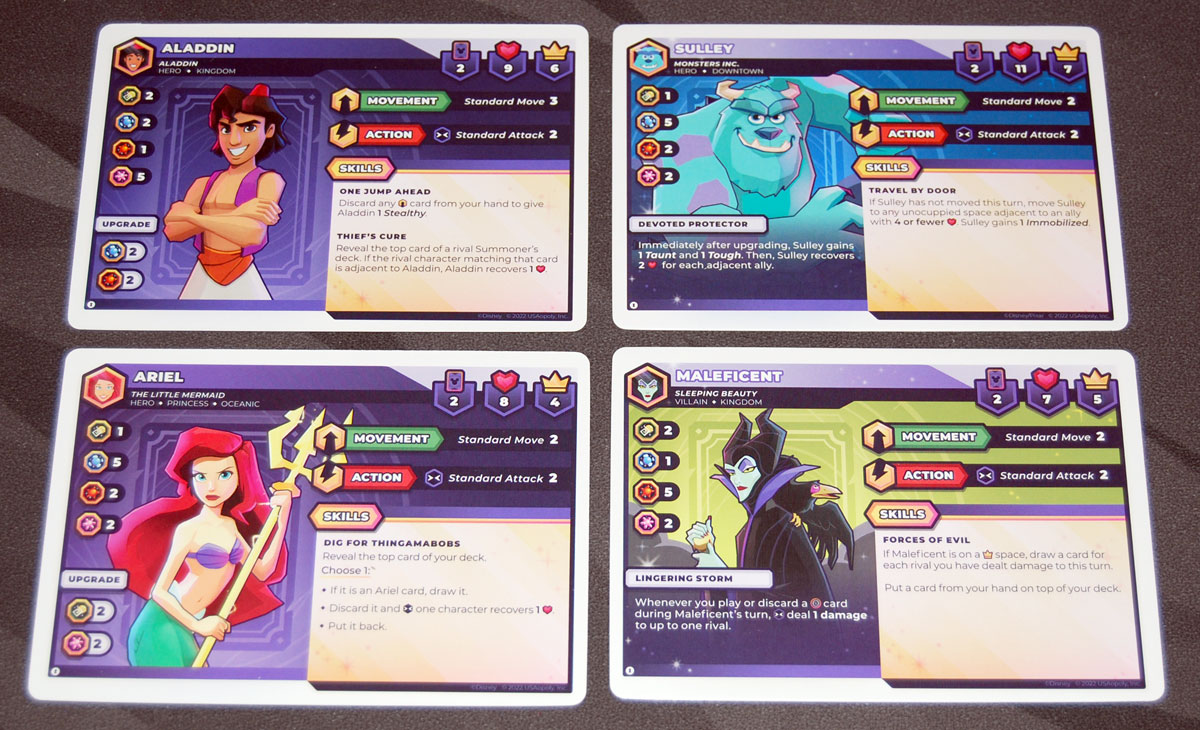
Disney Sorcerer’s Arena: Epic Alliances Core Set Characters
Here’s a quick run down of the characters included in the core set!
Aladdin
Aladdin is the only one in the base set with a standard move of 3, making him the fastest character, and his skills allow him to gain Stealthy or potentially heal himself. He also has a lot of movement in his deck, with several cards that can be used as movement or action. In upgraded form, he can banish cards from the opponent’s deck and draw more cards for himself.
Ariel
Ariel’s skill is “Dig for Thingamabobs” and gives you a good chance of drawing an Ariel card or healing your other characters. Upgrading Ariel boosts the effect of her healing cards—and Ariel is the only character in the core set who can heal other characters. She’s not a fast character, with only one movement card in her deck, but she has several cards that give you a choice of actions, which makes her flexible.
Demona
Demona (from Gargoyles) is pretty fast, with a few movement cards that let her speed across the board, and she also has both ranged attacks and area attacks that will do additional damage to adjacent spaces (but be careful not to hit your own characters with that!). Her skill is that if you play 2 Demona cards in a turn, you can clear status effects from her and gain 2 Strong, making her attacks more powerful. Her upgraded side gives you points when you’ve discarded 2 cards on her turn, but then she has to be upgraded again. Demona can be pretty powerful, but is a little trickier to use.
Dr. Facilier
Dr. Facilier (from The Princess and the Frog) is all about status effects. He doesn’t have much movement, but he has a lot of cards that add or increase status effects, plus he may get additional effects based on how many status effects a character has. His skill is revealing the top card of the deck, and if it has the magic icon he gets an additional action phase. When upgraded, he deals extra damage to adjacent rivals that have status effects, and gains bonus points for KO’ing them that way. He has a weak standard attack, though, so he’s not a great fighter.
Gaston
Gaston (from Beauty and the Beast) is a dumb and strong—he has a smaller hand size, but a lot of health. His “Boast” skill is a gamble: you may reveal the top card of your deck, and you’ll either gain Strong (making his attacks more powerful) or take a damage. When upgraded, Gaston gets to heal, move, and score extra points when he KO’s a rival. Gaston has a bit of movement and some powerful punches, and does extra damage if he can separate a character from its allies.
Maleficent
Maleficent is a magic-heavy character, and her skill lets her draw extra cards if she ends up on a scoring space and has done damage to other characters. Her upgraded ability lets her damage a rival every time she discards a magic card. She loves the crown spaces and has some cards that give her extra effects if she’s on the space, but my favorite card is Dragon Form, which restores her to full health and then does damage equal to the amount of health restored. Watch out!
Sorcerer’s Apprentice Mickey
Mickey is also magic-heavy, and has a special status effect that applies only to him: Magic Broom. He can discard magic cards to give himself a Magic Broom, and also has several action cards that give him more of that status. Not only does the Magic Broom boost some of his cards, it also gives Mickey the opportunity to stack his deck a little bit each time he removes one. Mickey has a mix of movement and actions, and pairs pretty well with other characters who also have magic cards in their decks.
Sulley
Sulley (from Monsters, Inc.) is the tank, with the highest health in the core set. His skill lets him teleport to a weakened opponent but then gives him an Immobilized so he can’t move on his next turn. When you upgrade him, he gains Tough (stronger defense) and Taunt (rivals have to attack him instead of another character), plus he can heal if he’s next to his allies. Sulley has a mix of actions but generally wants to be next to lots of characters, both allies and rivals, and can be effective at soaking up a bunch of damage.
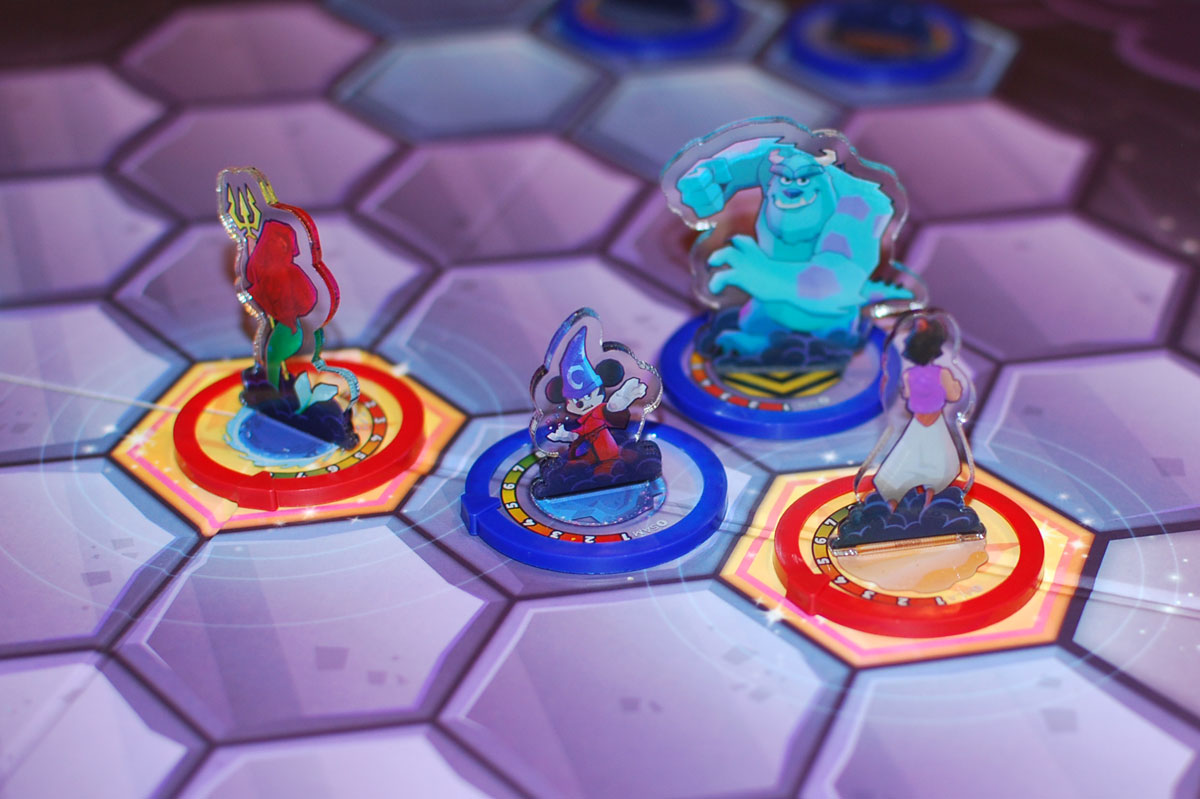
Why You Should Play Disney Sorcerer’s Arena: Epic Alliances
I remember seeing a lot of ads for an app called Disney Sorcerer’s Arena while playing games on my iPhone or iPad a couple years ago, featuring a mashup of characters: Mickey as the sorcerer’s apprentice waving his wand, Maleficent rising up from a cloud of smoke, Ariel swooshing in to zap with a trident. So last summer, when Disney Sorcerer’s Arena: Epic Alliances first showed up on my radar, it looked pretty familiar and I was intrigued to see what it would be like as a physical tabletop game.
But first, let me just say that the title is a bit too much, and it’s not clear how best to shorten it. Do I call it Sorcerer’s Arena or Epic Alliances? The expansion titles are even longer, with official names like
Disney Sorcerer’s Arena: Epic Alliances – Turning the Tide Expansion. I think if your core game has a colon in it, you’re already pushing it a bit. Presumably they tacked on Epic Alliances to distinguish it from the app (which doesn’t have a subtitle) but it just seems unnecessary.
Okay, on to the gameplay! Sorcerer’s Arena is a pretty easy-entry tactical strategy game. The box says it’s for 13 and up, but I played a few times with my 9-year-old and she didn’t have any trouble with picking up the rules, and I think the chapter system is a nice way to ease into the game. You start with the basics and are able to get going quickly and see how things work before you get to things like assembling a team and choosing your team’s turn order. And if you’re playing with younger kids, you can always keep playing at a particular chapter level for a little longer before throwing in the more advanced rules. I think for my kid, Chapter 3 felt about right, where she didn’t have to think about which gears were discarded to use for upgrading. If you’re playing with experienced gamers, you can probably skip ahead to a later chapter for your first game, though you’ll still need to read through the entire rulebook up to that point.
Of course, it’s one thing to learn the rules to a game, and it’s another to be able to win. While this isn’t chess (there’s some luck involved because you don’t know what cards you’re going to draw next), it does reward the ability to think ahead and guess your opponent’s next move. I’ve got more experience with that so I had a pretty good advantage over my kid. While there can be some surprises, particularly as you’re learning what each character can do, it’s generally going to be difficult for a new player to beat somebody who has some experience with tactical strategy games already.

That said, it has been fun exploring the different characters to see what they can do, and it will take a bit more practice to figure out how to build the most effective team. Not only is it important to consider the types of abilities each character has in their deck, but you also want to check which gears it takes to upgrade a character, and then build a deck that has those gears. For instance, to upgrade Aladdin, you’ll need 2 shell and 2 fire—but his character card shows that his deck only has 2 shell and 1 fire. If you pair him with a character that also needs fire to upgrade, you may not be able to upgrade them both during the game.
Overall, I think Sorcerer’s Arena is a fun way to mix and match characters from some of my favorite Disney and Pixar movies. They did a good job making abilities that fit the characters so that each one has its own style of play. I’m also excited for the expansions, which add even more characters to choose from—keep an eye out for some reviews of those in the coming months!
Road to Gen Con Contest
Right now, the Op is also hosting a “Road to Gen Con” contest featuring Sorcerer’s Arena! There are several regional events across the US starting tomorrow in Portland, Oregon, and you’ll need to bring your own copies of the characters you want to play in order to participate. The 1st place prize at each regional event is a trip to Gen Con to play in the World Championship Tournament, with various game promo components for 2nd through 6th place.
Here are the dates and locations for the regional events:
- January 14: Mox Boarding House – Portland, WA
- January 15: Mox Boarding House – Seattle, WA
- January 28: Meeples Family – Anaheim, CA
- February 18: Coliseum of Comics – Kissimmee, FL
- March 4: Millennium Games- Rochester, NY
- March 18: Miniature Market – St. Louis, MO
- April 15: Cape Fear Games – Wilmington, NC
- April 22: Oasis Games – Salt Lake City, UT
- May 13: Madness Games & Comic – Plano, TX
- July 8: Games & Stuff – Glen Burnie, MD
You can register for free through Eventbrite.
I don’t know that I’m very good at Sorcerer’s Arena, but I’m game to give it a shot since there’s a local event!
Click here to see all our tabletop game reviews.
![]() To subscribe to GeekDad’s tabletop gaming coverage, please copy this link and add it to your RSS reader.
To subscribe to GeekDad’s tabletop gaming coverage, please copy this link and add it to your RSS reader.
Disclosure: GeekDad received a copy of this game for review purposes.
Click through to read all of "Build Your Dream Team in ‘Disney Sorcerer’s Arena: Epic Alliances’ Core Set" at GeekDad.If you value content from GeekDad, please support us via Patreon or use this link to shop at Amazon. Thanks!

